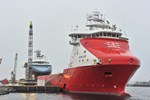The Norwegian energy giant Equinor has announced it has successfully reduced CO2 emissions from its logistical operations on the Norwegian Continental Shelf (NCS) by 600,000 tonnes since 2011.
600, 000 tonnes of reduced CO2, including from helicopters and vessels used for storage, rig moves, supply and emergency response, is the about the same amount as the annual emissions from all vehicles in Oslo, Norway. The company’s ambition is to halve emissions in the NCS supply chain by 2030.
Equinor also said that it plans to work with supply chain manager NorSea to open a shore-to-ship power supply station at its Dusavik supply base. The base is designed to provide shore power to vessels contracted to Equinor and charge their onboard batteries. Currently, 13 Equinor supply vessels have installed shore power systems, with five additional vessels being prepared this year.
Equinor Joint Operations Head, Phillipe F. Mathieu, said: “We need broad cooperation if we are to reduce emissions from our supply chain. Equinor plays a key role in this effort, as we have many suppliers who must be team players if we are to cut emissions.”
In addition to Dusavik, shore-to-ship power supply stations have been installed at supply bases in Mongstad, Florø, Hammerfest and Møre og Romsdal throughout 2018. These developments have been supported by the NorSea Group and its subsidiaries, with financial support from U.S.-based multinational Enova.
Mathieu added: “We have an ambition of moving all vessels on long-term contract with us to shore power because we have seen that it is an efficient tool for reducing emissions. We note that shipowners, crews, base companies and authorities are strongly committed and willing to prepare for operation and infrastructure that will help reduce emissions.”


